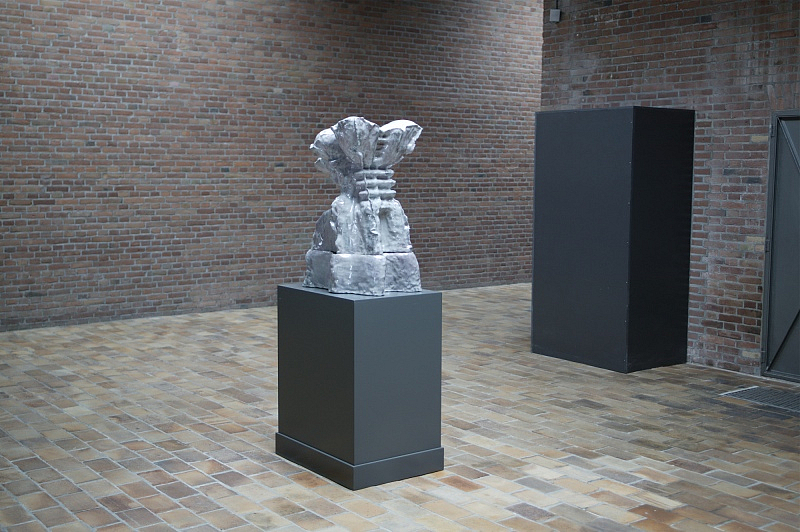In 2001 De Pont had already shown the monumental Green Room of Marien Schouten (Andel 1956) and since 2002 this work has been part of the permanent presentation. Green Room is a space whose walls are furnished with green-glazed tiles, each measuring approximately 25 x 65 centimeters and produced by Schouten during a work period at the European Ceramic Work Centre in ‘s-Hertogenbosch. The experience with ceramics acquired there and the wish to use this technique for large-scale work have also led to a new series of ceramic sculptures.
De Pont is now showing about ten large ‘heads’ that have been made since 2001. In addition to the sculptures in of fired clay, there are also several that have been carried out in plaster. While working at the EKWC, Schouten produced small-scale ceramic sculptures in whimsical forms. Gradually these developed into larger amorphous heads that have been modelled into crude shapes. Shoulders, neck and head emerge in a rough anatomy. The brown or moss-green layer of glaze heightens the impression of an organic growth that gives shape to the sculptures. Just as the robustness of these works shows the artist’s intention to create truly spatial forms, the treatment of the surface reveals his fascination with color and texture. On the one hand the glaze accentuates the form of the sculptures, of which sometimes only the edges are painted, and on the other the color scheme of green, brown and red is recognizably similar to that of Schouten’s paintings. On the plaster sculptures the pigment has been mixed with pumice grit, which gives rise to a rough texture, whereas the ceramic sculptures have a lustrous and smooth layer of glaze.
Rudi Fuchs once wrote about the “painterly space” in the work of Marien Schouten, which is marked by “a precarious balance between order and the overrunning of this by the weight of color and form, between rhythm and ornament, control and disruption.” This characterization also seems to apply to these sculptures and to the Green Room. Here, however, the ‘precarious balance’ becomes a strong symbiosis. In a recent publication Ernst van Alphen writes the following about Schouten’s Green Room: “Here architecture and surface concur: the texture is architecture.” The organic and the natural are clearly present in Green Room as well. Not only does the second title of this work (Snake) refer to the scale pattern of its ‘skin’; the color scheme also evokes associations with nature. Van Alphen writes: “Nature is not excluded here. By way of the deep green color of the tiles, some nearly black and others intense green, and by way of the glaze that sometimes reflects one’s gaze and then absorbs it, there inevitably arises an atmosphere of vegetation and a sense of landscape.”
The interplay of disciplines has long been a key aspect of Schouten’s work and has led to diverse forms of presentation. With the exhibited sculptures and Green Room, Marien Schouten has, for now, achieved a level of prominence in this endeavor.
